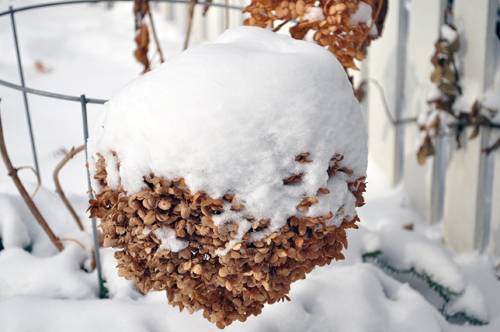Did the Polar Vortex Result in Dead Plants?
Return to Environment articles.
 The polar vortex in February with negative 30-degree wind chills left us all shivering in the cold. Many are now asking what affect the record-breaking cold had on our landscapes.
The polar vortex in February with negative 30-degree wind chills left us all shivering in the cold. Many are now asking what affect the record-breaking cold had on our landscapes.
This answer merits my classic answer to many questions – it depends. Many factors, such as the type, overall health, and location in the landscape, determine if there is any life left in your plants.
Time is the most telling factor in determining if plants were damaged or killed by the harsh temperatures. As the weather warms, spring growth begins.
Healthy buds should emerge, but those harmed by the cold will have poor flowering or branch dieback. There are a couple of tests to determine whether the plant has suffered any damage.
First is the scratch test. Take your fingernail or a sharp knife and scratch or cut into the bark layer of a branch. A healthy limb should have a moist and green cambium layer.
The cambium layer is the layer of cells conducting water to support new growth. If this layer dies, the plant no longer has a way to move vital nutrients to the branches.
Winterkilled tissue will be dry and brown. Another quick test of the branch is to bend it a bit. If it is flexible, that is a good sign. If it snaps, or is dry and brittle, the limb is dead.
It does take time for some branches to be dry enough to break. A combination of the scratch and bend test is best.
The second way to test for damage is by cutting into a developing bud. The bud is the powerhouse of the plant and the point of all new foliage in spring. Like the cambium layer, a healthy bud should be green and moist when cutting a cross-section.
Select several plump buds on the plant, and with a sharp knife, cut through the bud. If it appears green inside, it is more than likely alive. A dry or brown discoloration is not good news. A hand lens may be helpful as it enlarges the image to see any developing growth.
Even with these tests giving a clue to plant health, my advice is to wait and see. Let the plant show you what parts are alive. Winter injured plants will be slower to break bud in the spring. No growth means the limb is dead. At this point, prune out all winterkilled growth but the plant itself may not be dead.
Plants such as crepe myrtle, butterfly bush, and Hydrangea macrophylla most often suffer from harsh weather. These plants are often root hardy, meaning given time, developing stems from below the ground appear and renew the plant.
Be patient. Growth from below ground takes longer to develop, possibly even into May before appearing.
Time will tell the extent of the damage from the sub-zero temperatures. The good news is this arctic blast occurred in the dead of winter. Most damage from extreme temperatures happens in the early fall or late spring as the plants are not fully dormant, hardened off and prepared for the cold.
Sharpening your pruning shears might be a good idea. Then you will be prepared for the arrival of spring growth or, in this case, maybe the lack of growth.
By Dennis L. Patton, M.S., County Horticulture Agent, Johnson County K-State Research and Extension
Do You Have Questions?
Have questions? The Garden Hotline is staffed by trained EMG volunteers and Extension staff who will assist you with questions.
Phone: (913) 715-7050
Email: garden.help@jocogov.org